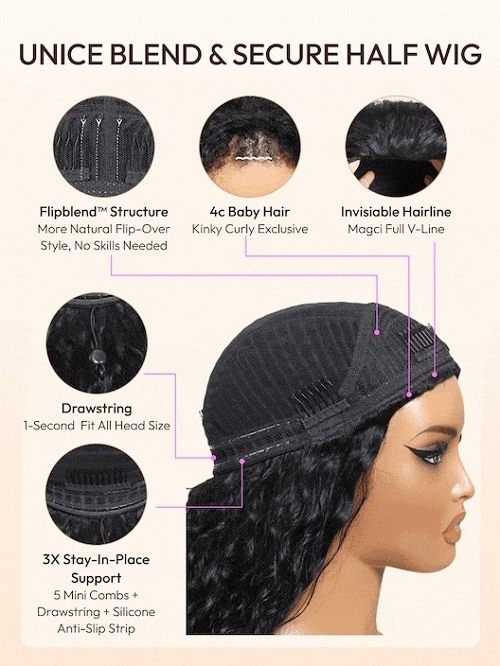
Half Wig vs. V Part Wig: Which One Is Right for You?
If you've seen wig lessons on TikTok or YouTube, you've undoubtedly heard the words "half wig" and "V part wig." They may appear to be twins, but don't be deceived 😉. Each has its own style, strengths, and optimum use. In this article, we're breaking down the differences, benefits, and downsides of both, so you can determine which one deserves to be in your wig lineup💁♀️✨.
What is a Half Wig?

Image: Wig by UNice
A half wig (aka a "3/4 wig") is like the cheat code of the wig world. It’s designed to cover only the back half of your head, blending with your natural hairline at the crown or temples. You leave your real hair out in the front (think baby hairs, bangs, or face-framing layers) to create a seamless look. Half wigs come in clips, combs, or elastic bands for easy attachment and removal.
Pros and Cons of Half Wigs
Pros of Half Wigs:

Image: Wig by UNice
✅ Breathable & lightweight: Perfect for hot weather or workouts since they don’t cover your entire scalp.
✅ Quick install: Clips or combs attach in minutes—ideal for rushed mornings.
✅ Versatile styling: Leave your natural hair out for a half-up, half-down vibe or slick it back for a ponytail.
✅ Budget-friendly: Less hair = lower cost compared to full wigs.
Cons of Half Wigs:
❌ Blending challenges: If your bio hair texture doesn’t match the wig, it might look obvious.
❌Limited coverage: Not ideal for thinning hair around the crown or edges.
❌Upkeep: Requires frequent repositioning if you’re active.
What Is a V Part Wig?

Image: Wig by UNice
V-part wig is genius for lazy-girl glam! It features a V-shaped opening at the top, allowing you to pull through a section of your own hair for a natural-looking blend. Unlike lace wigs, there’s no glue, no lace cutting, and definitely no mess. Most V-part wigs come with clips and adjustable bands to keep things snug and comfy.
Benefits and Drawbacks of V Part Wigs
Benefits of V Part Wigs:

Image: Wig by UNice
✅ Undetectable realism: That V part? Chef’s kiss. It’s flawless for a "Is that her real hair?" moment.
✅ Low-effort install: Skip the 2-hour YouTube tutorials. Just align the part with your natural one and snap it in.
✅ Breathable & lightweight: Less lace = less bulk. Great for hot climates or workouts.
✅ Styling freedom: Middle parts, deep side parts—rock any vibe without tweaking the wig.
Drawbacks of V Part Wigs:
❌ Limited parting options: You’re stuck with that pre-cut V shape. Want a zig-zag part? Nope.
❌ Sizing issues: If your head shape doesn’t match the wig’s V placement, it’ll look off.
❌ Higher price tag: Quality V parts cost more than basic half wigs.
Half Wig vs. V Part Wig: What’s the Difference?
Half wigs and V-part wigs offer unique benefits for different styling needs; understanding their differences ensures an informed choice.
| Feature | Half Wig | V-Part Wig |
| Coverage Area | Covers the back and sides of the head; front hair is left out for blending. | Covers most of the head with a small V-shaped opening at the top for minimal leave-out. |
| Blending Technique | Requires more natural hair at the front to blend seamlessly. | Requires minimal leave-out—only a sliver of hair along the V-part. |
| Installation | Secured with combs or clips; quick and beginner-friendly. | Clips or combs around the V-opening; no glue or lace needed. |
| Styling Versatility | Great for voluminous ponytails, half-up styles, and quick daily looks. | Offers a natural middle or side part; limited updo styling. |
| Best For | Anyone who wants a fuller look while showing their own hairline. | Those who prefer a no-lace, minimal leave-out option with a natural part. |
Coverage Area
1️⃣ Half Wigs: Cover the back of the head, leaving the front natural hairline exposed for blending.
2️⃣ V-Part Wigs: Typically full wigs that cover the entire head, featuring a V-shaped parting space designed to integrate with natural hair.
Blending Technique
1️⃣ Half Wigs: Require leaving out a portion of natural hair at the front to style and blend with the wig.
2️⃣ V-Part Wigs: Pull a small section of natural hair through the V-shaped part for a seamless, scalp-like look.
Installation
1️⃣ Half Wigs: Easily clipped or sewn into the back of the head, focusing on blending with the front hair.
2️⃣ V-Part Wigs: Precise placement—aligning the V-part with the hairline is crucial, often achieved with adjustable straps or combs for a secure fit
Styling Versatility
1️⃣ Half Wig: Often used for quick volume or length. Great for ponytails, half-up styles, or casual everyday looks.
2️⃣ V Part Wig: Ideal for a more polished, natural finish. Better for the center or side part hairstyles.
Best For
1️⃣ Half Wig: Beginners looking for affordable, beginner-friendly options or protective styles with a natural hairline.
2️⃣ V Part Wig: Those wanting a natural-looking part without lace, glue, or heavy manipulation. Great for low-maintenance wear.
Final Thoughts
Half wigs are your laid-back, mix-and-match BFF, while V part wigs are the chic, low-maintenance queen you take to brunch. Your choice boils down to your lifestyle, hair goals, and how much effort you’re willing to invest. Whichever you pick, slay with confidence—because great hair is always a mood booster!
